The Directors of Arowana International Limited (Arowana) are pleased to announce that Thermoscan Inspection Services Pty Ltd (Thermoscan), a wholly owned subsidiary of Arowana and Australia’s leading independent thermal inspection services provider, and Raptor Maps Inc (Raptor Maps), the US’s foremost solar intelligence company and provider of AI solutions for aerial imagery analysis, have entered into a strategic partnership to deliver the Australian solar industry’s highest-quality service for asset inspection using drone-enabled thermography.
The partnership comes as Thermoscan expands into the provision of inspection services to a domestic solar industry experiencing significant growth in the number of utility-scale assets in operation. Bloomberg forecasts capacity for utility-scale solar, where aerial inspection has material cost and efficiency advantages over alternatives, to increase from 0.5 GW at the end of 2017 to 4.9 GW by 2020.
For solar asset owners and developers, aerial thermography is fast emerging as a preferred maintenance and analysis solution, helping to identify faults in assets of increasing size and demonstrating strong dollar returns in recovered electrical capacity post-remediation.
Raptor Maps, who develop custom, end-to-end machine learning and AI solutions for enterprises that leverage drones and aerial data, has been at the forefront of this developing maintenance market in the US. The company creates digital replicas of solar assets and applies custom algorithms as part of a fault identification and localisation process that reduces turnaround and increases accuracy versus human analysis.
Thermoscan intends to take advantage of its position as Australia’s leading provider of thermography services and its strategic partnership with Raptor Maps to assume material market share of this emerging addressable market in Australia. Under the terms of the strategic partnership, Raptor Maps, as Thermoscan’s preferred provider for the term, will deliver solar intelligence services through close integration with Thermoscan’s operational and business processes to enable rapid, high-quality turnaround.
Thermoscan’s General Manager, Kelly Alcorn, indicated this was a pivotal point in the company’s expansion plans: “We are extremely excited to partner with the Raptor Maps team who already have such a strong pedigree in what is an emerging industry, especially in Australia. Drone-enabled thermography opens up a large addressable market for us in utility-scale solar, one to build on our existing 1,600-strong client base.”
Nikhil Vadhavkar, Co-founder and CEO of Raptor Maps, states: “Thermoscan has built a reputation as a trusted nationwide service that focusses on accurate thermographic data capture and actionable reporting. We are excited to power them with our industry-leading asset models and analytics, trained with over 10 million solar panels, to enable Australia’s clean-energy future.”
Thermoscan understands that it is at the inflection point for the Australian solar market, and there is strong demand for high-quality analytics to optimize asset management and increase performance.
About Thermoscan
Thermoscan is 100% owned by Arowana International Limited and is a leading provider of thermal imaging services across Australia with a team of highly qualified technicians, all with 10 or more years of electrical engineering experience and ITC thermography certifications. Thermoscan currently provides non-destructive testing services to identify faults or defects in electrical systems and building structures to over 1,600 clients.
About Raptor Maps
Raptor Maps is the global leader in unmanned aerial thermal analytics for solar assets. The company uses artificial intelligence to analyse thermal drone data, store the results in a digital replica, and provide analytics to financiers, asset owners, asset managers, and maintenance companies. Raptor Maps has analysed over 3 GW of solar assets in 2018 thus far, detecting millions of dollars in annual production losses. It was founded by MIT engineers, graduated the elite Y Combinator accelerator, and serves customers across six continents.

As an operator of SMEs, Arowana is continuously on the learning path to ensure our operating companies are focussing on the right areas at the right times.
Staying on top of research pieces and surveys provide valuable insights into what trends might have an impact on small and medium-sized businesses. And with the internet age making global business instantaneous, what applies in one country can now be relevant for the entire business community.
One such report that was released in 2018 was the PwC Global Investor & CEO Survey. a series of online interviews that PricewaterhouseCoopers conducts annually with investors and CEOs. The primary aim of these surveys is to gain insights into the thinking and strategic goals of chief executive officers to see how their views compare with those of the people investing in their companies. Within the responses from these key stakeholders, the following are the four key areas that we think are of particular importance to SMEs.
What areas should businesses be aware of?
The four areas we identified are: cyberthreats, disruptive technologies, automation, and difficulties in attracting the right talent. Let’s take a closer look at each of these, and what we believe these will mean for SMEs going forward
Cyberthreats
This is obviously a major concern for both investors and CEOs. IT governance issues need to be addressed, but how does an entrepreneur tackle this threat on their own?
If you Google “cyberattacks”, you will find lots of information on how governments and major corporations have been victims of a cyberattack. These are organisations that have dedicated teams and budgets aimed at protecting against such threats.
However, this is often not the case with SMEs, who are potentially more vulnerable to cyberattacks, which can lead to reputational damage, financial loss, and data breaches.
A successful cyberattack on an SME can have a much bigger impact than on a large organisation, as they may not have the ability to sustain losses, or the disruption caused to their business.
So how can SME protect itself from cyberthreats? Firstly, awareness that these types of attacks can occur is key, as well as always being vigilant about what is being received on our computers and portable devices.
You also need to be organised. Having an IT governance framework may sound like something for the large companies but is in fact even more crucial for SMEs. Our competitive advantage is our ability to create value by optimising technology.
Today, the traditional attack vectors of hacking the firewall (although still significant) are no longer as prevalent as they used to be, due in part to changes in traditional work practices. Once, you would go to your office in the morning and log on to a desktop computer to access the IT system, which was protected behind the physical barrier of a firewall.
Hacking the firewall was the only way to get into a company’s IT system. But the workforce now accesses IT resources from anywhere, at any time and on any device.
This, in conjunction with the rise of cloud-delivered IT services and applications, means hacking the person has become more common than hacking the firewall. It is far easier, quicker, and requires less skill.
41% of CEOs and 41% of investors surveyed are concerned about cyberthreats.
The best defence against this is for SMEs to have a culture where IT security is everyone’s responsibility, and not just the IT team’s, although they still need to lead the charge.
Having a knowledgeable staff and strong security protocols are just as important today as having traditional firewalls in place 20 years ago. Therefore, a recurring IT training program is a must for organisations of all sizes.
A good analogy here is that a loaded gun is not dangerous until someone decides to pull the trigger. Likewise, an email with a malicious payload is not dangerous until someone decides to click on the attachment.
So, IT governance certainly plays a key role. We should not only be focussing on preventing cyberattacks, but we should also be equally watchful about how they can occur and how we manage the aftermath.
At some point most, SMEs will experience some sort of cyberattack. If you haven’t already, then expect it. It will happen. That’s why you need to have strong procedures in place to deal with the aftermath. Cybersecurity insurance for SMEs is also another option that is becoming more accessible to many companies.
In minimising the damage, time is of the essence. Knowing what you have, where it is located, and what has been stolen will assist you in dealing swiftly with the situation. And with new regulations such as GDPR now in force, knowing your legal obligations will help to ensure that you fulfil your responsibilities to government, clients, and staff.
Disruptive technologies
Disruption by technology is not a new phenomenon. In 1970, the most common profession in the world was the typist. The advent of the desktop computer disrupted the typewriter, and the typist was extinct by the late 1990s.
From an SME perspective, technology has been an invaluable tool that has helped entrepreneurs start up faster and leaner than ever. This is a threat to major corporations whose margins are being eroded by the new kids on the block.
The Black Eyed Peas have called it the ‘Now Generation’, but this is the reality of the world we live in. We no longer want to wait in the call queue, especially if it’s just to ask a question. Instead, we use online technology to research the product or service in detail, mostly during a commute or in the wee hours.
AI Chatbots who can answer customer enquiries also improve the customer experience and facilitate the buying process. It’s no secret that if a business isn’t using their customer data to improve their service, then someone else certainly is.
Technology such as social media platforms are providing SMEs with the ability to generate leads by running targeted ad campaigns for their products and services, which is far cheaper than traditional media.
85% of investors expect technology to greatly disrupt the business landscape in the coming years.
And with this greater ability to target an audience, consumers are requiring greater transparency about products or services before making a buying decision. They want to align their own beliefs with a brand and business that has an authentic purpose and a similar vision. SMEs can compete as well, if not better, than large corporations in this regard.
According to Zendesk, 75% of people would return to a company with excellent service, but 87% think brands need to work harder to create a seamless experience for customers. Today, more businesses have an omnichannel approach to servicing their customers to ensure they manage the customer experience from initial enquiry all the way through to sale and delivery.
At Arowana International, two of our companies have specifically employed technology to improve their customer experience. These are Thermoscan, a thermal imaging company which―through the digitisation of paper-based processes―now provides customers with a report within 24 hours of an inspection; and DDLS, which now delivers industry-certification programs across Technology, Process, and People product verticals through the adoption of state-of-the art technology.
Automation
Investors expect automation to reduce headcount to some extent in the future. We are already seeing some of this now. But at Arowana International, we believe that what this is really doing is freeing up the capacity for smaller businesses to focus on more creative and strategic thinking rather than repetitive tasks.
While CEOs are more concerned than investors about the loss of jobs that automation will bring and their obligation to retrain staff, at Arowana International we believe it’s a matter of perspective.
Automation will inevitably reduce headcount and just as in the example of the typist, those who reskilled as computer-literate secretaries continued to be employed.
From an SMEs perspective, automation will help save time and improve margins. RPA (robotic process automation) specialists can introduce software and tools into our processes that will do menial, repetitive tasks with zero errors. This will in turn free up our time, enabling us to concentrate on strategic and revenue-generating tasks.
Attracting talent
In the PwC survey, investors believed that creating learning opportunities and providing a modern and flexible work environment are the most important factors for attracting the right talent to a business.
We at Arowana International, fully agree. In an increasingly hi-tech world, the rate of knowledge decay is escalating (around 6% per annum according to Prof. Boris Groysberg of Harvard Business School) and our knowledge and skills half-life is becoming shorter and shorter.
This means that everyone, whether they are blue-collar, white-collar, back office, middle office, or front office, will need to take a leaf from the book of Tim Ferris―the world’s greatest learner―and embrace a mantra of lifelong learning to stay relevant in a rapidly automating world.
At Arowana International, we practise what we preach. We believe in lifelong learning and consider it vitally important that our team not only remain relevant, but also have skills and experience that are future-proofed in order to assist our companies to scale up sustainably.
We continually invest in learning programmes spanning leadership, technology, marketing, data science, and finance. Each team member is allocated an annual online education budget to expand their knowledge base.
A good example of how we are helping SMEs find suitably skilled employees is our company EdventureCo, a leading vocational and professional education provider specialising in building, construction, and information technology. EdventureCo’s goal is to equip students with relevant skills in a rapidly changing world where jobs are becoming increasingly displaced by automation.
Our conclusions
While investors and CEOs may differ in some regard, the PwC Global Survey clearly shows that both groups recognise the major challenges facing business in both the short and long term. Hopefully this article has shown that many perceived challenges such as technology and automation can actually become opportunities for SMEs, particularly for those who work with the right hands-on partner.
Arowana International partners with businesses that serve a real purpose in society and who need our support to achieve sustained growth. We use our experience and rigorous research and data analysis to help SMEs develop and overcome the inevitable hurdles without ever losing sight of the long term.
These advances are attributed to several factors, including the application of new statistical approaches and the increased processing power of computers. But in a recent Perspective in the journal Neuron, we argue that one often overlooked contribution is the use of ideas from experimental and theoretical neuroscience.
Psychology and neuroscience have played a key role in the history of AI. Founding figures such as Donald Hebb, Warren McCulloch, Marvin Minsky and Geoff Hinton were all originally motivated by a desire to understand how the brain works. In fact, throughout the late 20th Century, much of the key work developing neural networks took place not in mathematics or physics labs, but in psychology and neurophysiology departments.
With so much at stake, the need for the field of neuroscience and AI to come together is now more urgent than ever before.
At DeepMind, we argue that despite rapid progress in both fields, researchers should not lose sight of this vision. We urge researchers in neuroscience and AI to find a common language, allowing a free flow of knowledge that will allow continued progress on both fronts.
We believe that drawing inspiration from neuroscience in AI research is important for two reasons. First, neuroscience can help validate AI techniques that already exist. Put simply, if we discover one of our artificial algorithms mimics a function within the brain, it suggests our approach may be on the right track. Second, neuroscience can provide a rich source of inspiration for new types of algorithms and architectures to employ when building artificial brains. Traditional approaches to AI have historically been dominated by logic-based methods and theoretical mathematical models. We argue that neuroscience can complement these by identifying classes of biological computation that may be critical to cognitive function.
Take one recent example of a seminal finding in neuroscience: the discovery of offline experience “replay”. During sleep or quiet resting, biological brains “replay” temporal patterns of neuronal activity that were produced in an earlier active period. For example, when rats run through a maze, “place” cells activate as the animal moves around. During rest, the same sequence of neuronal activity is observed, as if the rats were mentally reimagining their past movements, and using them to optimise future behaviour. In fact, it has been shown that interfering with replay impairs performance when they later perform the same tasks.
At first glance, it might seem counterintuitive to build an artificial agent that needs to ‘sleep’ - after all, they are supposed to grind away at a computational problem long after their programmers have gone to bed. But this principle was a key part of our deep-Q network (DQN), an algorithm that learnt to master a diverse range of Atari 2600 games to superhuman level with only the raw pixels and score as inputs. DQN mimics “experience replay”, by storing a subset of training data that it reviews “offline”, allowing it to learn anew from successes or failures that occurred in the past.
Successes like this give us confidence that neuroscience is already an important source of ideas for AI. But looking forward, we believe it will become indispensable in helping us tackle unsolved questions, such as those concerning efficient learning, understanding of the physical world, and imagination.
Imagination is a hugely important function for humans and animals, allowing us to plan for future scenarios without taking action; something that may come at a cost. Consider a simple example, such as planning a holiday. In order to do this, we leverage our knowledge - or “model” - of the world and use it to project forward in time, evaluating future states, and allowing us to calculate the route we need to take or what clothes to pack for sunny weather. Cutting-edge research in human neuroscience is starting to unveil the computational and systems mechanisms that underpin this kind of thinking, but much of this new understanding has yet to be incorporated into artificial models.
The fields of neuroscience and artificial intelligence have a long and intertwined history
Another key challenge in contemporary AI research is known as transfer learning. To be able to deal effectively with novel situations, artificial agents need the ability to build on existing knowledge to make sensible decisions. Humans are already good at this - an individual who can drive a car, use a laptop, or chair a meeting are usually able to cope even when confronted by an unfamiliar vehicle, operating system, or social situation.
Researchers are now starting to take the first steps towards understanding how this might be possible in artificial systems. For example, a new class of network architecture known as a “progressive network” can use knowledge learned in one video game to learn another. The same architecture has also been shown to transfer knowledge from a simulated robotic arm to a real-world arm, massively reducing the training time. Intriguingly, these networks bear some similarities to models of sequential task learning in humans. These tantalising links suggest that there are great opportunities for future AI research to learn from work in neuroscience.
But this exchange of knowledge cannot be a one-way street. Neuroscience can also benefit from AI research. Take the idea of reinforcement learning - one of the central approaches in contemporary AI research. Although the original idea came from theories of animal learning in psychology, it was developed and elaborated by machine learning researchers. These later ideas fed back into neuroscience to help us understand neurophysiological phenomena, such as the firing properties of dopamine neurons in the mammalian basal ganglia.
This back and forth is essential if both fields are to continue to build on each other’s insights, creating a virtuous circle whereby AI researchers use ideas from neuroscience to build new technology, and neuroscientists learn from the behaviour of artificial agents to better interpret biological brains. Indeed, this cycle will likely accelerate thanks to recent advances, such as optogenetics, that allow us to precisely measure and manipulate brain activity, yielding vast quantities of data that can be analysed with tools from machine learning.
We therefore believe distilling intelligence into algorithms and comparing them to the human brain is now vital. Not only could it bolster our quest to develop AI, a tool that we hope will create new knowledge and push forward scientific discovery, but may also allow us to better understand what’s going on inside our own heads. That could shed light on some of the most enduring mysteries in neuroscience, such as the nature of creativity, dreams and, perhaps one day, even consciousness. With so much at stake, the need for the field of neuroscience and AI to come together is now more urgent than ever before.
This article was originally published on DeepMind.
Authors:
DDLS has been awarded the prestigious EC-Council ATC Circle of Excellence Award for 2017/18. This award recognises DDLS’s outstanding contributions to developing and upskilling Australia’s cybersecurity workforce.
The award was announced at EC-Council’s Global Annual Awards 2018, which celebrates and recognises the achievements of top cyber executives, partners, and graduates working to advance the cybersecurity workforce.
At the awards ceremony, the President of EC-Council said: “We have some of the best training organisations representing EC-Council across the globe and they have again demonstrated the commitment to high-quality training.”
EC-Council, also known as the International Council of E-Commerce Consultants, is the world’s largest cybersecurity technical certification body, operating in 145 countries globally. DDLS has partnered with EC-Council to deliver training in cybersecurity courses, including Certified Ethical Hacker and Certified Network Defender in Australia.
DDLS was awarded the top prize out of 750 delivery partners across the world. DDLS’s CEO Jon Lang said: “This award is a testament to the strong partnership forged by EC-Council and DDLS, brought together by a mutual goal of offering comprehensive, globally-recognised cybersecurity training in Australia, and helping Australian individuals and organisations better protect themselves from the ever-increasing risk of a cyberattack.”
VivoPower has partnered with IT Power (Australia) Pty Ltd to jointly develop a portfolio of utility-scale ground-mounted solar projects in New South Wales.
VivoPower International PLC (Nasdaq: VVPR) (VivoPower), a global solar power company, is pleased to announce that its wholly-owned subsidiary in Australia, VivoPower Pty Ltd (VivoPower Australia) has entered a partnership with IT Power (Australia) Pty Ltd (ITP) to jointly develop a portfolio of utility-scale ground-mounted solar projects in New South Wales, with an initial aggregate capacity of at least 50 MW and the opportunity to add additional capacity over time. VivoPower and ITP intend to design, contract, finance, and construct each project on a rolling basis.
VivoPower has demonstrated a successful track record with utility-scale solar projects, having developed, constructed, and financed projects representing more than 90 MW of generating capacity over the past two years.
Carl Weatherley-White, Chief Executive Officer of VivoPower, said: “VivoPower is excited about this major solar development initiative in the New South Wales market, which represents a significant expansion of our Australian footprint, and is also highly complementary to the solar initiatives of our subsidiary, Aevitas. We are very pleased to be working with ITP, a highly successful and respected partner with demonstrated experience in the Australian renewables market.”
Simon Franklin, Managing Director of ITP, added: “ITP is delighted to be working closely with VivoPower on this exciting enterprise. VivoPower has been highly successful with their international solar farm development projects and combined with our extensive local experience in the Australian energy market, we are confident of success.”
About VivoPower
VivoPower is an international solar power producer and storage company that develops, builds, and operates projects on a global basis in a capital-efficient manner. VivoPower does this by aggregating photovoltaic (PV) solar projects underpinned by long-term power purchase agreements, arranging corporate and project financing, engineering, design, and equipment procurement as well as managing the construction and development of such solar PV projects.
About IT Power Australia Pty Ltd
Established in 2003, ITP is a renewable energy consulting and engineering company working on projects of all sizes for governments, corporations, aid agencies, and energy providers in Australia. As part of the wider ITP Energised Group, one of the first consultancies to bring together specialists in renewable energy, energy efficiency, and carbon markets, ITP draws on more than three decades of experience delivering thousands of renewable energy projects around the globe. Within the ITP Energised Group, ITP leads work in the Australian and Asia-Pacific region and works globally with ITP Energised Group partners.

Looming shortage
Australia's skills gap has been receiving a significant amount of coverage, and research indicates that three in four Australian CEOs are concerned about a looming shortage in key occupations and skills. The conversation about the national skills gap encompasses a few different dimensions. First, technological change and automation will likely drive a digital skills gap. Second, skills gaps are affecting cities and regions in a different way. Third, employers, industry groups, and other stakeholders are planning to tackle the issue in a range of ways.
Where's the skills gap?
The skills gap affects a range of occupations. Digital and technology-oriented occupations like engineering, ICT, and science technicians have, unsurprisingly, been identified as among those facing a shortage. Electrotechnology and telecommunication trades workers are also occupations affected by shortages in regional areas.
However, there is also a shortage of technicians and certain tradespeople. These include automotive and engineering trades workers, and construction trades workers. Beyond these, occupations like architects, surveyors, health professionals and construction engineers are also experiencing shortfalls. The National Skills Needs List has a full list of trades professions with a supply deficit.
White collar occupations are also affected by Australia's skills gap. According to the Skills Shortage List Australia by the Department of Jobs and Small Business, shortages or recruitment difficulties are affecting professional occupations such as those of architects, surveyors, civil engineering professionals, and veterinarians. The solicitor occupation is also currently impacted by recruitment difficulties, as are health occupations like sonographer, optometrist, audiologist, physiotherapist, midwife, and pharmacist. Different shortages might exist for individual states and territories as well as regional areas, and this might account for the additional occupations on the lists for eligible skilled occupations for migration. For example, the lists includes extra (to the Skills Shortage List Australia) white-collar occupations like aeroplane pilots, aeronautical engineers, accountants, barristers, cardiologists, dentists, and registered nurses.
Technological change and automation as drivers
Technological change and automation are some of the things causing our skills gap. Research suggests automation could replace one in six jobs in Australia by 2030, and some observers predict it's on target to take away an average of four hours of work each week. While technological implementation will lead to new business models that allow staff to produce more value, the balance of skills and work will likely be shifting, and the extra value will likely require upskilling to achieve. So, transitioning workers, perhaps through better in-work training, and ensuring future workers have the right skills could be the key, and companies play a vital role in this shift, though government policy could also play a significant supporting role. Companies may be embracing this role by recognising that technological implementation could lead to new business models that allow staff to produce more value. A majority (54%) of Australian CEOs see it as their responsibility to retain employees whose tasks are displaced by automation. At the same time, 74% of employees think upskilling is their responsibility. Research, however, suggests leaving it to employees could be less efficient than businesses taking charge to reskill.
Businesses seeking to get ahead of the technology-driven skills shortage would do well to embrace the trend and understand how it will impact their organisation. Assess what will be lost and gained, and focus on the customer. Audits could help identify key areas for reskilling and a variety of training options could be used, from microskilling to external training.
Businesses should note the skills gap may impact more than just digital skills. Soft skills like problem solving, leadership, and emotional intelligence will likely be as important as digital skills. As Bianca Pickett, Head of Head of People & Culture at Kiandra IT, states, "Being able to communicate effectively, to build rapport, to understand what a client really wants, and deliver to that, is far more important nowadays, and in our experience, rare."
The bottom line is to have a clear plan as technology and automation disrupts your skills requirements, and ability to fulfil these changing skills needs.
Cities vs regional areas
Skills gaps are impacting Australian businesses differently depending on their location. Growth in high-skilled jobs, for example, is concentrated in the nation's biggest cities. In rural and regional areas, gaps in lower-skilled roles are growing fastest.


Everthought does all training face-to-face, and this ensures all students have the support and knowledge to progress through their chosen course. In addition, we also offer flexible training delivery through Workplace Training where we visit students in their workplace and train them in the current work environment. We work with industry to ensure that our training is relevant and up-to-date with modern industry practices and standards. This is evidenced by the fact that we train people onsite in their workplaces, which ensures all trainers are exposed to what is occurring in workplaces.
Presently there are skills shortages in traditional trade areas in Australia. This places vocational providers in a unique position to provide training with a real focus on outcomes through tried-and-tested training methodologies.
Recently, there has been a major shift from traditional classroom-based training to a mix of online and blended training options. This has started to reach into the trades training space with several vocational providers offering a flexible delivery mode or 100% online delivery method. This has in turn, had an adverse effect on completion rates with many people not receiving the support they require to complete courses. This lack of completions is having an impact on supplying qualified workers to industry and widening the skills shortage gaps.
Additionally, existing workers that may have the skills and years of industry experience are often overlooked for positions as they don’t hold a formal qualification.
This has led to a shift in thinking about how we qualify people that have the experience, skills, and knowledge and haven’t gone through a traditional apprenticeship. Recognition of Prior Learning (RPL) is a method that is being used in the vocational sector to evaluate a person’s experience, skills, and knowledge against the formal qualification framework. RPL assists in formally qualifying skilled people and ultimately satisfying shortage gaps in the workforce. By providing flexible and new ways to obtain qualifications, we can start to bridge the gap in developing skilled workers through non-traditional methods whilst maintaining high completion rates.
As the General Manager of Everthought Education, I am seeing firsthand the benefit of RPL and other innovative methods to upskill and train the workforce. I believe that a healthy balance of new and existing training methodologies is paramount for developing a skilled workforce and attracting new workers into the trades space.

The skills gap is too often short-sighted. The skills gap is commonly referred to as the disconnect between the skills the current workforce has as compared with the jobs currently required.
We take a different approach at DDLS: whilst the skills gap of today is of paramount importance, we focus on what is coming. What are the skills we need to be trained in today for the jobs of tomorrow?
"A report released from Bersin by Deloitte states that 47% of today’s jobs will be entirely redefined in 20 years and even more alarming is that 65% of today’s students will do jobs that don’t yet exist. DDLS focuses on ensuring it is offering training in the latest technologies and provides options for the current skills gap, but more importantly, also focussing on the jobs of tomorrow."
We work closely with our vendors, industry, and students to ensure we have the latest training courses on offer. A recent survey of DDLS customers received more than 5,000 respondents with 50% of them identifying the need for cloud technology training due to the business going through digital transformation and migrating all technologies to the cloud within the next 12 months. We aim to address the skills gap by focussing on role-based learning and aligned experience.
The key is no longer offering certification for certification’s sake, but rather, identifying role requirements, and ensuring training is linked to role outcomes. All DDLS courses are internationally recognised certifications, and this is key in addressing the skills gap which is becoming increasingly borderless. With the ability to deliver training remotely and looking to expand its offerings offshore, the identification of the skills deficiencies in countries outside Australia allows DDLS to ensure its course offerings are not just Australian-focussed. Businesses are increasingly utilising offshore staffing solutions to meet the demand of their local goods and service requirements―it is therefore important for any Australian-based training company to ensure it is reviewing the skills gap globally.
DDLS is Australia’s leading, trusted training partner offering learning solutions across IT, process management, and professional development. DDLS designs, develops, and delivers innovative learning solutions from certification through to customised learning programs to enable clients to confidently deploy technology and effectively manage processes and people for their business growth and success. With national training facilities in Sydney, Melbourne, Brisbane, Perth, Adelaide, and Canberra, DDLS provides the highest quality learning programs, Technical Instructors, Trainers, and Facilitators to train over 15,000 students a year. Students are trained from beginner to specialist and advanced levels, fully transforming their effectiveness.
*Jon is an accomplished leader with a strong passion for education and a drive for building successful and sustainable businesses. Jon brings to DDLS an extensive career in the education sector and will support the DDLS team to drive toward an innovative and successful future.
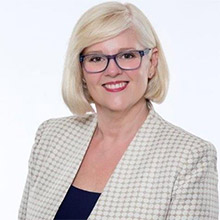
The nature of work in Australia is changing. Regardless of what we call it―the Future of Work, Industry 4.0, or the Fourth Industrial Revolution―we need to respond for Australia to remain strong, competitive, and productive.
This period of rapid change, driven by advances in new technology, is irresistible, and while our education and training sectors have been gearing up for it, I don’t think we’re responding quickly enough.
Technologies like artificial intelligence, robotics, 3D-printing, and autonomous vehicles present huge opportunities. We will only seize these opportunities if our education and training systems are more responsive to change, delivering the skills that business and industry will rely upon and ensure future generations of graduates and workers can grasp new and emerging opportunities.
As Assistant Minister for Vocational Education and Skills, I have a keen focus on restoring VET’s status as a training system of choicena centre of excellence where people can get real skills for real careers.
Having the VET sector better integrated with our university sector, combining their complementary strengths, is critically important as we deliver the skilled workers that business needs.
The Australian Government, through the Australian Industry Skills Committee, created the Digital Transformation Industry Reference Committee, ensuring the training sector responds to greater automation and digitalisation of work by adopting future-focussed skills.
Our Pathways in Technology (P-TECH) pilot, to operate at 14 sites around Australia, will help to meet the emerging demands for new and varied skills.
P-TECH offers secondary school students an industry-supported education pathway to a STEM related post-school qualification. Students have the option to continue their study at the tertiary level or pursue employment in a STEM-related field, including with the school’s industry partners.
These steps will help future-proof the national training system.
Aside from the technical skills to grapple with emerging technology in the workplace, our education system, be that schools, university, or VET, must also instil and nurture fundamental skills such as critical thinking, creativity, teamwork, and lifelong learning.
The workforce Australia needs to face the changing nature of work involves more than just the knowhow to operate new technology, it requires resilience to weather the change, and initiative to turn a challenge into an opportunity.

Digital technology has been steadily infiltrating Australian schools over the past decade, but a curriculum change to support this new technology has been, in my opinion, long overdue. Subjects such as computer science, coding, and data science have as of 2018 been added to the new digital technologies curriculum in a bid to reverse the current downward trend of PISA Scores recorded in Mathematics and Science by Australian students. But is this enough? After all, NSW―one of the most populated states in Australia―has not even set a date for when they will be making the subjects mandatory in schools. But I have been asked the question: what does this change mean for the future for educational institutions?
"With the new digital technologies curriculum, I believe schools need to ensure that the relevant teachers are being provided with the resources, support, and the time needed to learn and engage with these subjects. This is essential to ensure that teachers are equipped to educate their classes to the best of their ability, and thus prepare today’s students adequately for a technology-based future."

Population growth, the rise in birth-rates, and the ever-growing need for good quality child care has been driving the demand for more qualified early childhood workers the country over. According to the Department for Employment, there are currently over 120, 000 workers in the childcare industry, most of which are employed full-time, while many others work flexible hours. This is expected to rise by over 20,000 workers, meaning there is a strong growth in this sector.
As the Director of the Training College of Australia, an RTO that specialises in Cert III and Diploma Courses in Early Childhood Education and Care, I have been aware of the gap in skills in the industry for some time. And it is one that not only needs fixing, but deserves ongoing training and development of existing workers. After all, we are talking about the people that are leading our future leaders through the early learning stages of their life.
While the industry has largely been dominated by women, we are seeing more and more men entering childcare and early childhood development roles, which is great to see.
And, while traditionally a lot of young people were enrolling in these training courses, it is surprising how many middle-aged and return-to-work students take to this industry, especially mothers, after having had children themselves.
One of the unfortunate trends across the childcare sector is the rampant switching of jobs and frequent changing of staff in kindergartens and childcare centres. This can be disrupting to a child’s development. For an example, we work closely with Arndell Early Childhood Learning Centre where our diploma students do their practical placements. Unlike many other centres, their staff retention is exceptionally high with staff being there eight years, 10 years, and longer.
They are however, committed to ongoing staff development and professional training across all their careers. We have had a lot of them coming to our CPD and First Aid trainings and to upgrade their qualifications to diplomas.
One thing that cannot be stressed enough, is that staff and carers need to keep adding to their skills base, be committed to ongoing learning, and treat this profession more like one of teaching rather than just taking care of our young children. However, this sentiment needs to come from centre management and operational staff as much as from those working directly with our next generation.

We are combatting this issue from the point of view of solving employee underutilisation which is a $305bn/year problem. Our industries are becoming much more contract-based and the reality of contract-based industries are that contracts get cancelled, delayed, or simply don't line up, creating expensive gaps where businesses have valuable staff “sitting on the bench” in between contracts, just chewing into company cashflow.
Research shows that 27% of the workforce is underutilised at any point in time, so we believe that by accessing this untapped talent in businesses, we can reduce the talent shortage burden and increase productivity in our industries.
We do this with our proprietary B2B talent mobility platform that matches a business's idle staff who are in-between projects or contracts, to short-term contracts from other companies seeking specialist or surge support.
In this way, businesses can now manage the peaks and troughs in industry with either paid contracts for their staff in the troughs or access to the high-quality talent hidden inside Australia's best businesses. We have effectively created the largest untapped talent pool in the country―the Happily Employed!
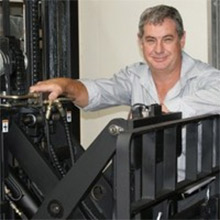
I have managed my own business in the forklift industry for more than 40 years. Over that time, we have employed many plant, electrical, and auto mechanics for repairs and maintenance on our equipment. In this time, we have taken on apprentices and over the past five years, we have only had one complete their qualification. There is a lack of young people coming through the trades that is creating a skill shortage in the industry.
The biggest reason, I believe, that young people don’t complete their trade is that the apprenticeship system fails them. The scheme has not evolved for decades, with low wages and no gratification.
We need to change the system to reflect now, and we need to look at the way skills are taught.

At Kiandra, we recruit for a variety of different roles, from deeply technical to senior leadership. We aim first, to hire the best technically-skilled person for the role. Given this, there has been a stark skills gap in Software Developers and Seniors Networking Engineers with Azure. But the real gap is not in tech skills, it’s in soft skills. There has been a trend amongst the more technical people we have met for roles to lack the ability to talk to clients, deliver exceptional client service, and to meld and work in a team environment efficiently. These are vital workplace skills, to which there is a huge glaring gap.
This was very clear when a technician told me they had never spoken to their client while fixing a recent issue. They preferred using the time to solely focus on the problem rather than hold a simple conversation to ensure the client had a good experience. Whilst the problem was fixed―good client management and service should’ve been part of this process.
I often say to engineers that you are better to keep your client happy and informed, than you are to have delivered a perfect technical outcome, and they often look at me perplexed.
It’s like going to a café. If you get an average meal, but the service is amazing―meaning the server engaged you and made the experience great―the average food can be forgiven. Being able to communicate effectively, to build rapport, to understand what a client really wants, and deliver that, is far more important nowadays, and in our experience, rare.
To bridge this gap, technical people should be seeking out soft skills training on top of their tech knowhow. This includes how to communicate better, teamwork, and make sure that self-reflection is part of a continuous improvement journey.
The skills gap is clearly a major issue for both business and government, and initiatives for addressing it exist both at policy and enterprise levels. For example, there's the Australian Apprenticeships Incentives Program. This program offers employer incentives and personal benefits for apprentices undertaking certain qualifications (Certificate III or IV qualification) that lead to occupations like mechanics, electricians, hairdressing. In addition, certain occupations with skills shortages could be targetted by the skilled migration program.
At the enterprise level, employers can utilise strategies to attract more in-demand employees to their business but reskilling according to a clear plan is also an option. The plan should reflect what's happening in terms of disruptive trends like technology and how this impacts your business and customer relationships. Different training options, including continuous learning and development programs, could be part of the plan. How you manage your employees could also be part of the solution. For example, encouraging innovation and a culture of collaboration could allow your employees to deliver more value by focussing on capabilities that can't be replaced by machines, as automation takes over lower-skilled functions.
What industry leaders suggest
Tackling the skills gap as a nation will involve better engagement between employers and training providers, ensuring that education and training programs are relevant and staying relevant as technological advances see the industry evolve. As industry leader insights suggest, it can start from nurturing future leaders through the education sector as well as curriculum changes in schools and better support for teachers. At the enterprise level, targeting specific technology trends like big data, AI, and cloud security could be part of organisations' plans. Businesses could benefit from targeting soft skills as well as hard skills, as this can directly impact customer service and competitiveness.
At the government-policy level, it could be about responding to technology changes by focussing on specific policies like boosting the Vocational and Professional Education and Training (VPET) sector's status as a training system and better integrating it with the private sectors. Similarly, supporting more young people in trade with policy-based incentives could address the low-wage and no-gratification perceptions, and target the trades-category shortages. With both government incentives and business-level initiatives, Australian industry can successfully work to overcome the skills gap challenge to build a stronger, future-proof workforce.
Arowana is an operator of small and medium sized companies, and a specialist asset manager. We grow people, companies, and value. We operate EdventureCo, a leading vocational and professional education and training platform in Australia that is expanding across Southeast Asia. At EdventureCo, we have established specialist, reputable college brands in blue-collar and white-collar VPET fields such as building and construction, and information technology. In the last six years we have successfully trained over 65,000 students in our eight campuses across Australia to provide them with the skills and qualifications to advance their careers and employment prospects to support them in upskilling and reskilling. Our mission is to equip students with the in-demand skills they need to find employment in a rapidly changing world, where jobs are increasingly being displaced by automation and robotics.
To find out more about what Arowana can do for your business, reach out to us through: https://arowanaco.com/connect/
To learn more about our team at EdventureCo. and how we help businesses reskill and upskill, explore our website
VivoPower International PLC (Nasdaq: VVPR) (VivoPower), a global solar power company, is pleased to announce that its wholly-owned subsidiary in Australia, Aevitas Group Limited (Aevitas), has been awarded a significant contract for the engineering, design, procurement, and construction of the 3.6 MW Cubbie Solar Project near Dirranbandi in Queensland, Australia. The project will be owned by a wholly-owned subsidiary of Cubbie Ag (Cubbie), the largest cotton producer in Australia, and will produce electricity to help power Cubbie Station, the largest irrigation property in the Southern Hemisphere.
J.A. Martin Electrical Pty Limited (J.A. Martin), a division of Aevitas, is responsible for project delivery. The project is expected to generate enough electricity to supply 40% of Cubbie’s energy needs at Cubbie Station during the peak cotton ginning season, which runs from April to September. It is also the first phase of a longer-term plan to expand to 7.2 MW and will also include battery storage. Construction is scheduled to begin in October 2018, with expected commercial operation by December 2018.
Carl Weatherley-White, Chief Executive Officer of VivoPower, said: “We are very pleased to have achieved this significant milestone in our strategy to offer holistic solar and battery storage solutions to commercial, industrial, and government customers in Australia. This important contract is further confirmation of the strong growth outlook for Aevitas from solar and other tailwind drivers in Australia.”
Phil Lowbridge, General Manager of J.A. Martin Electrical Pty Limited (J.A. Martin), said: “Technical advances continue to drive the competitiveness of solar power generation and battery storage, and we have seen increased interest from our customers for similar solutions.”
About VivoPower
VivoPower is an international solar power producer and storage company that develops, builds, and operates projects on a global basis in a capital-efficient manner. VivoPower does this by aggregating photovoltaic (PV) solar projects underpinned by long-term power purchase agreements, arranging corporate and project financing, engineering, design, and equipment procurement as well as managing the construction and development of such solar PV projects.
About Aevitas
Aevitas is a wholly-owned subsidiary of VivoPower in Australia. Aevitas provides critical energy infrastructure generation and distribution solutions including the design, supply, installation, and maintenance of power and control systems, with an increasing focus on solar, renewable energy, and energy efficiency. Founded in 1968, J.A. Martin is a division of Aevitas that specializes in delivering industrial and electrical engineering and power services, including solar engineering design, procurement, and construction (EPC).
The Directors of Arowana International Limited (AWN) are pleased to announce that DDLS, Australia’s leading Information and Communications Technology (ICT) learning provider has completed a rigorous onboarding and assessment process to become Australia’s only national “Google Cloud Authorised Training Partner”. DDLS is part of the EdventureCo group, the leading vocational and professional education and training (VPET) group in the Asia-Pacific and a wholly-owned subsidiary of AWN.
DDLS will be providing Google cloud training from its nationwide training centres in Perth, Brisbane, Sydney, Melbourne, Canberra, and Adelaide, and via its telepresence capability. Adding Google Cloud training to the portfolio provides significant choice to organisations who need skilled staff to deploy Google Cloud, including Google Cloud in a hybrid solution, or those evaluation cloud platforms.
The deal with Google continues the positive momentum that DDLS is experiencing. Earlier in this calendar year, DDLS also became Microsoft’s only Gold Cloud Learning Partner in Australia and is a training provider under Microsoft’s subsidised enterprise class cloud computing training initiative to public sector workers in Australia. The addition of Google Cloud Training will build on DDLS’s position as a leading provider of cloud-based training in the country.
Jon Lang, CEO for DDLS commented: “Use of cloud-based services is no longer the next big thing, but rather, business as usual. With Google Cloud already a leader in the Gartner magic quadrant, helping Australia remove risk and successfully deploy and manage Google Cloud through training is a business priority for DDLS. We are delighted by this partnership and thank Google for their support.”
DDLS is planning to add other Google courses including Data, Machine Learning, and Application development in 2019.
About DDLS and EdventureCo
DDLS is 100% owned by EdventureCo, which is a wholly-owned subsidiary of Arowana International Limited. EdventureCo is a leading vocational and professional education and training (VPET) group in Australia and is expanding into the ASEAN region.
DDLS is Australia’s leading, trusted training partner offering learning solutions across IT, process management, and professional development. DDLS designs, develops, and delivers innovative learning solutions from certification through to customised learning programs to enable clients to confidently deploy technology and effectively manage processes and people for their business growth and success. With national training facilities in Sydney, Melbourne, Brisbane, Perth, Adelaide, and Canberra, DDLS provides the highest quality learning programs, Technical Instructors, Trainers, and Facilitators to train over 15,000 students a year―ranging from beginner or specialist to advanced levels―and transforming their effectiveness.
“EdventureCo’s vision is to build an Asia-Pacific leader in vocational and professional education and training. Our mission is to deliver relevant skills first and qualifications second, enabling students to upskill and reskill, addressing the skills needed tomorrow, today.”
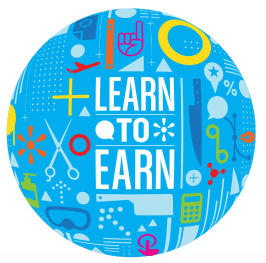
At Arowana, we founded and scaled up a vocational education company called Intueri Education Group (Intueri) which in a period of four years became the largest private VET group in New Zealand, with a fast-growing and highly profitable online business in Australia.
Intueri was initially formed in May 2010 with the purchase of a small Christchurch-based vocational college called the Design and Arts College. We subsequently executed a buy and build strategy, overcoming numerous growing pains challenges, including the debilitating impact of two earthquakes in Christchurch, to scale up Intueri from NZ$1m EBIT to NZ$20m EBIT between May 2010 and May 2014. Intueri was IPOed in May 2014 at a market capitalisation of NZ$235m, with its share price closing 15% up on its first day of trading and subsequently peaking at a 40% premium to its IPO price in December 2014. The IPO delivered a capital gain in excess of NZ$100m for Arowana and we retained a 25% shareholding in the company.
In the ensuing three years post-IPO, unfavourable regulatory changes in New Zealand adversely impacted Quantum, one of Intueri’s subsidiary colleges that trained second chance learners, primarily of Maori and Pacific Island origin. Furthermore, tougher immigration rules targeting students of Asian descent were introduced, which curtailed the growth lever buoying the other colleges in New Zealand. Meanwhile in Australia, an abrupt tightening of government regulation across the VET sector in the space of 18 months had a materially adverse impact on Intueri’s Australian business. This led the group to experience significant earnings deterioration, and it was ultimately broken up and sold in April 2017.
We have learned several key lessons from this experience:
(1) Minimise exposure to Regulated Training VET models
A Regulated Training ecosystem, as currently exists in Australia and New Zealand, is almost by definition politicised, which means it is subject to regulatory volatility. In such an ecosystem, education policy is linked to the politically sensitive arena of employment policy (as previously discussed in Part II). So, when macroeconomic conditions change or governments change, there can be significant swings in policy and regulatory conditions.
Intueri felt the full brunt of this in Australia. When Intueri purchased Online Courses Australia (OCA) in February 2014, government policy was highly supportive of private VET providers. At the time, generous VET incentives were in place that were introduced by a federal Labour government in 2012 as part of its strategy to drive vocational education. This was replicated at state government level especially in Victoria, which also had a Labour government at the time. With the benefit of hindsight, regulatory settings were too generous as reflected in relatively lax rules around course fee levels (no caps), completion rates (no minimum levels), and other aspects of training delivery. As a result, there were a handful of rogue operators that took advantage by overcharging for courses, enrolling unsuitable students, and failing to achieve acceptable completion rates.
A new Liberal/Conservative federal government was elected in September 2015 and uncovered an estimated US$2.5bn budget blowout. This, coupled with negative media headlines on certain rogue operators prompted the federal government to swiftly tighten regulatory settings. In October 2016, OCA along with numerous private players had its licence to deliver VET courses and government funding revoked despite the fact it had previously passed all government audits. The regulatory goalposts had changed and done so abruptly.
By October 2017, an estimated 80% of the private VET FEE-HELP providers that were in operation 4 years prior had their licences revoked in what was effectively a government “blitzkrieg”. In February 2018, the second largest VET player in Australia, Study Group, owned by the US private equity fund, Providence, had its licence revoked, meaning a clean sweep of the top three largest players was completed. The regulatory pendulum had swung from very lax in February 2014 to ultra-tight by February 2018.
Unfortunately, Intueri had a similar experience in New Zealand, primarily in relation to Quantum, which was the largest college in the group. Before announcing its purchase of Quantum in late February 2014, Intueri’s business was of a similar size from a revenue and profits perspective. When it was approached to buy Quantum in September 2013, it was clear that such an acquisition would create by far the largest private VET group in New Zealand. As a result of its rescue of and commitment to the earthquake damaged D&A College business in Christchurch and subsequent purchases of other VET colleges in New Zealand, Arowana had always maintained a cordial and open relationship with the key education regulators in New Zealand. The TEC (Tertiary Education Commission) and NZQA (NZ Qualifications Authority) had been engaged regularly and they had been consistent, commercial, and forthright in our dealings, just as we were with them. As part of our ongoing engagement with the TEC, Arowana had been informed by the TEC that the two issues that it was particularly sensitive towards were (i) excessive use of gearing, which we did not engage in, and (ii) foreign ownership, which they considered Arowana as such.
Our due diligence process was typically rigorous (or so we thought) and encompassed the following elements:
What we thought was a very robust due diligence process was however not enough to mitigate against what ultimately unfolded. We were perhaps naïve to rely on what a government regulatory body says directly in a face-to-face meeting, nor should we have placed reliance on the comprehensive audit report issued by the regulatory body on the Quantum business just two months prior to the acquisition. Despite conducting two rounds of rigorous due diligence involving external accountants, auditors, and lawyers as well as having an industry expert consultant who formerly worked for a NZ regulator, this was ultimately not enough.
Following some negative articles in NZ’s financial press in 2015, including one criticising NZ’s education regulators in relation to Quantum, the TEC commissioned Deloitte in November 2015 to undertake a forensic investigation into Intueri and Quantum. Deloitte conducted an extensive range of interviews including present and past board and staff members of Arowana, Intueri, and Quantum. Deloitte delivered its draft report to the TEC in September 2016, but the final report was only released the week before Christmas 2017. It is to be noted that both the FMA (Financial Markets Authority) and the Serious Fraud Office (SFO) of New Zealand had also been called into action to investigate the IPO of Intueri and its acquisition of Quantum. The former did not raise any material issues while the latter's investigation was dropped.
While our Intueri experience demonstrates that minimising exposure to Regulated Training VET businesses is prudent, we are not suggesting that they are categorically un-investable. In fact, there is an optimal time to invest in such businesses. This moment in time is what we call the “plateau of overregulation” which forms part of the regulatory dialectic cycle (see diagram below). It is when regulations have been tightened too much and overreached.
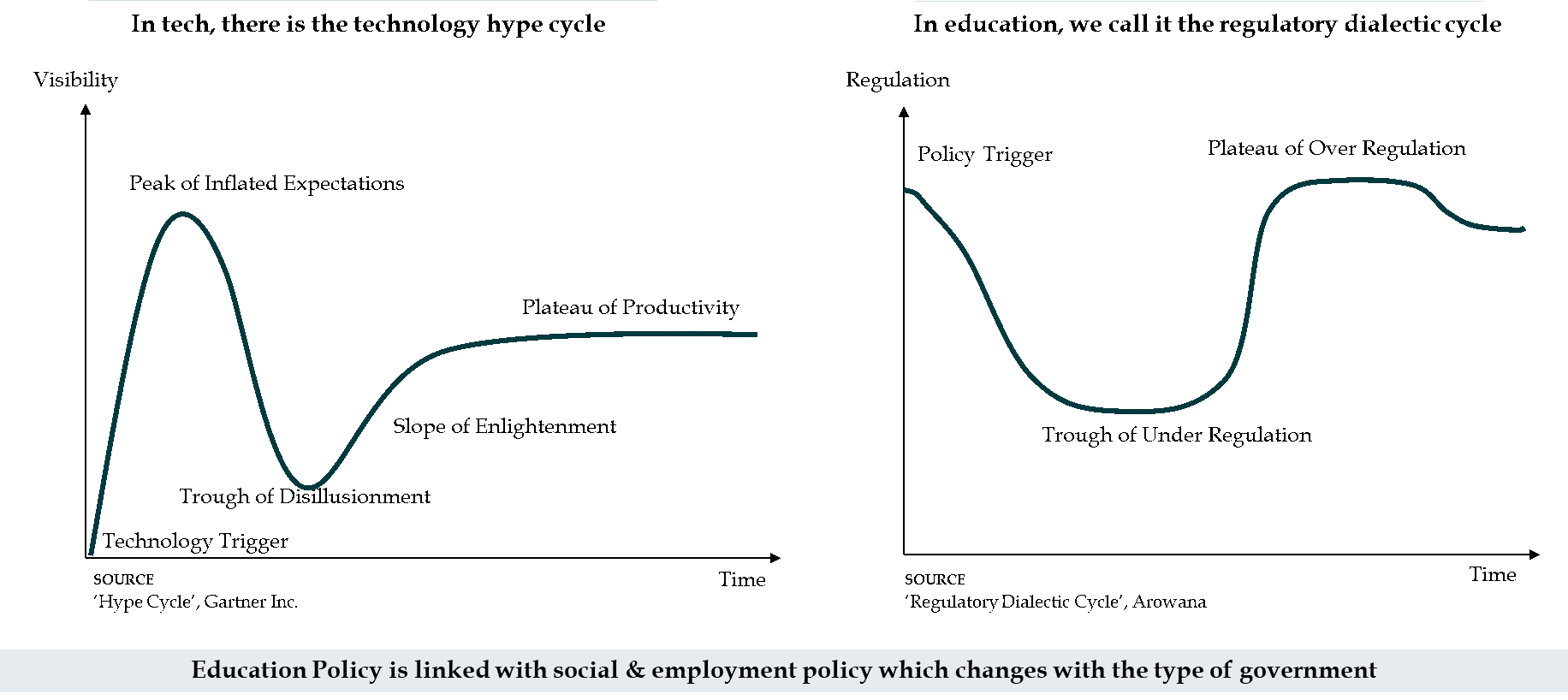
In such times, VET businesses can potentially be purchased at “out of favour” valuation multiples that overcompensate for the regulatory risk. Subsequently, what tends to happen is that the regulatory overreach is adjusted within two to three years, and operating conditions normalise. In short, opportunities can present themselves to purchase these types of VET businesses at trough valuation multiples on trough earnings.
(2) Maximise exposure to employer-led and fee for service VPET models
As we have seen from the Part II discussion on VET models, the “gold standard” is the dual VET model practised in Switzerland. The reason for its success is the heavy involvement of employers in curriculum design and teaching delivery. Importantly, the delivery is primarily through on-the-job workplace training, and this ensures that the skills taught are relevant. Some VET courses lend themselves better to this type of delivery model because they are more tactile in nature, such as carpentry, traffic control, and hairdressing. However, in a Regulated Training ecosystem, politics can inadvertently or deliberately prevent such a delivery model being effective in practice. For example, Intueri owned the largest hairdressing college in the country. Hairdressing businesses routinely complained about the lack of suitably qualified staff, which could have been solved by hairdressing trainees undertaking training on the job. But long-standing political rivalry between government regulated training colleges and an industry-driven apprentice training body stymied this from happening systematically.
It has taken Switzerland the best part of 30 years to get to its current VET system and culture, so this will not happen overnight in countries that do not practise a dual VET model. Outside of Europe, there is only South Korea that practises a proper dual VET model. However, as noted in Part II, we are of the view that Singapore will rapidly execute on its new VET strategy, modelled on Switzerland, and become a global leader within the next decade. As a respected education thought leader in ASEAN and China, we expect the Singapore model will influence policymakers in these countries to embrace and similarly apply a dual VET model (as has happened in other areas of education).
In addition to employer-led VET business models, there are also fee for service VET models where students pay their own tuition fees, without any government subsidies or incentives. These are often the most attractive education businesses because the students are confident of a job outcome that will deliver a sufficiently attractive return on invested fees and time that they are prepared to pay for it themselves. This category includes international fee for service students that attend VET colleges in countries like Australia, Canada, Singapore, and New Zealand. Typically, these VET colleges also cater to domestic students, but on a subsidised basis.
(3) Focus on larger addressable markets with diversity of skills shortages and deep management talent pools
Skills shortages can be cyclical, as exemplified by the peak mining boom years of 2010 to 2012. In commodity countries like Australia and Canada, this caused all types of outsized and somewhat perverse skills shortages. For example, McDonalds in the mining town of Mackay in Queensland, Australia had to import store managers from the Philippines because all the locals had gone to work in the mines. There was such a chronic shortage of electricians that it caused a bubble in pay, with “sparkies” as they are known in Australia earning between US$100,000 and US$300,00 per annum, significantly above normal levels. Fast forward to 2018, and this situation has normalised.
We believe however that this is a window into the future of skills gaps―skills shortages will rapidly manifest but will tend to have a shorter half-life mirroring that of shorter industry and company lifecycles, thanks to the ever-increasing pace of technological disruption. A VPET business will not be able to survive, let alone scale by focussing on one or two skills areas but must instead have a portfolio of skills that it covers and trains for. Furthermore, an effective VPET group will not only need to be adept at predicting future skills gaps but also have a culture of pace to develop courses quickly to train for such skills shortages. For example, the International Association of Privacy Professionals (IAPP) estimates that the introduction of the General Data Protection Regulation (GDPR) will trigger a need for more than 75,000 data protection officers (DPOs) globally within the next two years. This is a brand-new role that has been created and defined by GDPR and initially there will be a mad scramble for the very few suitably qualified DPOs that currently exist. However, within three years, it is likely that most of this skills gap will have been largely filled as companies, VPET businesses, and data professionals alike rush to meet the demand. Interestingly, prior to the introduction of GDPR, Germany and the Philippines were the only countries that had mandatory DPO laws. For the Philippines, I believe GDPR is a significant strategic opportunity as it tries to work out how to combat the existential threat to its Business Process Outsourcing (BPO) industry posed by artificial intelligence (both machine learning and deep learning).
Also, in markets where private VET businesses have only been a relatively recent development, it can be difficult to find suitably qualified general and technical managers who balance strong teaching pedagogy and commercial nous. This balance is important to ensure a VET business is delivering strong teaching outcomes in a profitable and sustainable manner. If a leadership team is overly focused on quality outcomes and compliance, it can lead to a situation where a business is unprofitable. Conversely, if a leadership team is too focussed on maximising shareholder profits, this can lead to poor teaching outcomes and/or compliance breaches. We experienced these challenges firsthand with Intueri where it was compounded by the fact that the group was experiencing strong scaleup growth during Arowana’s ownership (which can stretch the best of management teams).
(4) Focus on markets where government & society do not consider VET inferior to tertiary education
In building Intueri, we experienced firsthand how VET can be treated as a “second-class citizen” by education policymakers, bureaucrats, and regulators alike, inferior in their minds to tertiary academic education. This will never be voiced publicly especially when there are minority interest groups involved but it is felt when you are operating within the industry.
“What I think is happening around the world now is that governments are beginning to actually say that we need a mix-skills economy. Yes, it is good to have graduates, post-graduates, PhD doctorates, but much of the work which needs to be done to make our society, industry, and business work is actually done by highly qualified technicians, craftsmen, and professionals in those areas. I think that realisation is meaning that policies of governments are changing.”
Simon Bartley, President of World Skills
Such a mindset has been common in many countries over the past 40 years as they strived to improve education standards. In this regard, the percentage of a population with a university degree was considered the key measure of success. However, the percentage of university graduates globally that do not have a job in their field of tertiary study has increased significantly in the past decade. We have all met the career bartender or waitress with a master’s degree in a restaurant in New York, a café in Sydney, or a bar in London. Meanwhile at the same time, more employers are lamenting the inability to find staff with practical vocational skills and this “skills gap” has resulted in high levels of youth unemployment globally.
More progressive governments and education policy makers have recognised the mindset above as antiquated and sought to address it. In Switzerland, the public sector, the private sector, and society at large accord equal merit to both academic and vocational routes. This is also the case in Germany, Austria, and Denmark for many years.
“Vocational training is the "backbone" of the education system and the Swiss economy as the skills acquired through vocational training are those that are demanded by the labour market.”
Former Swiss President Johann Schneider-Ammann
More recently, Singapore is an interesting case study. Singapore society is built on a Confucian mindset and attaining a university degree has been the “holy grail” for parents and students in this 60-year young nation. However, over the past five years, the Singapore government has recognised the skills gap issue and the threats posed by the Fourth Industrial Revolution and an aging population. It has worked to change the lowly perception of VET amongst general society, teachers, and students alike by modernising ITE (Institute of Technical Education) campuses, increasing the range of curricula, and introducing an Earn and Learn model. The results have been impressive with ITE’s brand equity score jumping from 34% in 1997 to 68% in 2015, reflecting a much-improved perception of VET amongst Singaporeans.
Investing in and operating a VET business in markets where there is an inherent elitist bias against VET presents greater risk of disadvantageous regulatory settings and adverse budget allocations. It is important to be able to recognise and mitigate against such risks.
Our strategy and execution plans with regards to scaling up EdventureCo have been heavily influenced by the lessons learned above. In a period of less than two years, EdventureCo has become one of the largest private VPET businesses in Australia as well as the broader Asia-Pacific region. It has less than 10% revenue exposure to the Regulated Training ecosystem in Australia, with the balance of the business not exposed to regulation nor in receipt of any government funding.
EdventureCo’s vision is to build an Asia-Pacific leader in vocational and professional education and training (VPET). Across all its course offerings, EdventureCo works with employers and industry to design and deliver curricula that is relevant. Relevance to employers is key to ensure successful job outcomes.
Our mission is to deliver relevant skills first, and qualifications second, enabling students to upskill and reskill―addressing the skills needed tomorrow, today. Whilst its business is currently Australian-centric, EdventureCo is focussed on growth and skills shortage opportunities in selected markets across Asia, in conjunction with suitable local partners.
“The Swiss vocational education model is considered the “gold standard”, as it has achieved what few countries have been able to do―which is closure of the skills gap and maintaining very low levels of youth unemployment and underemployment. The “earn while you learn” apprenticeships are highly regarded by students and employers alike, and the permeability of education pathways has fostered a culture of lifelong learning in Switzerland.”
As a result of nearly a decade of being an investor in and operator of vocational education colleges, we have studied various models of delivery being practised globally.
There are essentially four models of vocational education and training being practised around the world:
The essential difference between each model is who holds the balance of power in designing curricula and delivering vocational education programmes: the government (through its education and/or employment ministries) or the private sector (employers and trade associations). The Dual VET model is primarily driven by the private sector while in a Regulated Training ecosystem, the government is the key player. This has important ramifications for the effectiveness of the different models, as discussed below.
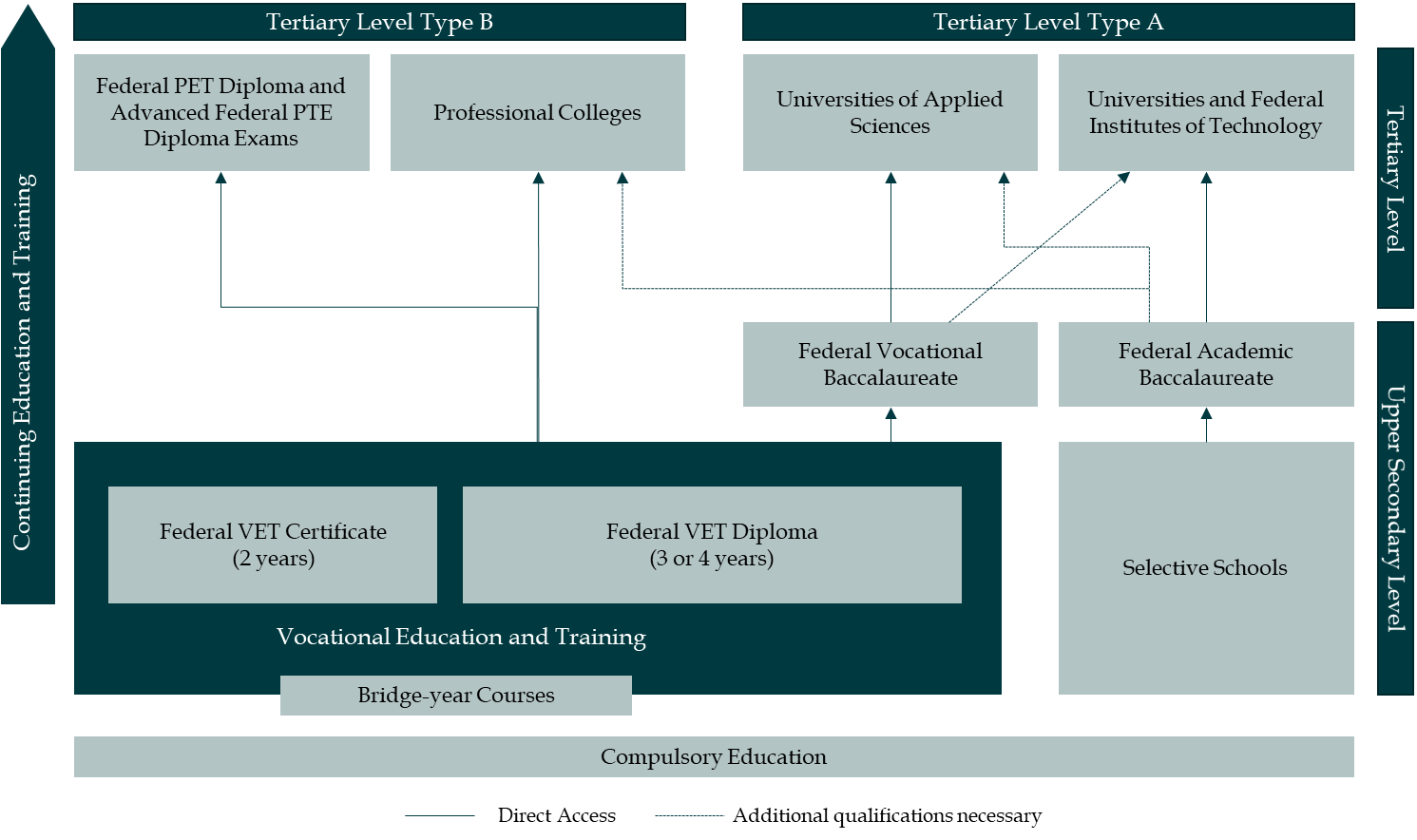
Switzerland (as per diagram above), Germany, Austria, Denmark, and more recently, South Korea, operate a Dual VET model. Using Switzerland as an example, the key features of a Dual VET model are as follows:

Finland consistently ranks as one of the top three in the world for its education system and outcomes. It operates a School-based VET model as do Poland, Slovenia, and Lithuania. This model is like the Dual VET model, but the key difference is that most of the training is delivered in a classroom setting rather than the workplace.
The key features of a School-based model include as follows:
The school-based VET model is like the dual VET model but has less private sector involvement and has a heavier classroom delivery weighting.
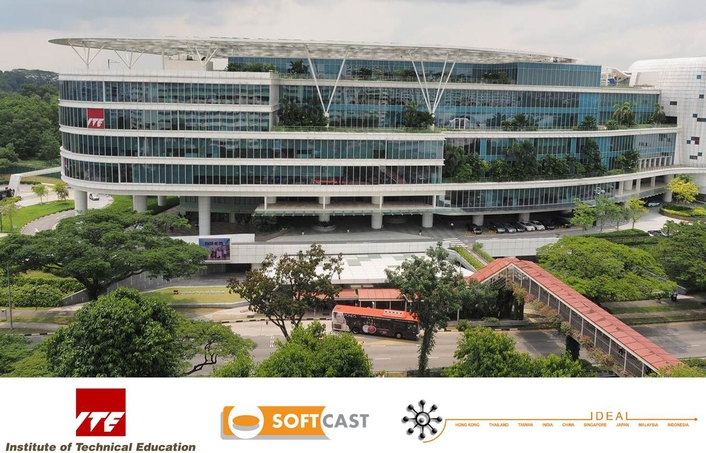
Singapore has traditionally practised a Career Education VET model with its Institute of Technical Education (ITE) and polytechnics as the centrepiece.
The key features of a Career Education model include the following:
It is to be noted that Singapore has been reviewing its VET strategy and recently introduced a range of new VET initiatives including an Earn and Learn program. Back in 2015, the Singapore government acknowledged that it needed to learn from and embrace more of the Swiss “gold standard” dual VET model and change the culture of education design and delivery as well as society’s view of vocational education. Led by its Deputy Prime Minister, Tharman Shanmugaratnam, Singapore has been studying the Swiss VET model with a view to future-proofing its economy by dealing with a tight labour force and the increasing rate of change of skills in the modern workforce. Singapore is now actively championing lifelong learning through upskilling and reskilling with the SkillsFuture Singapore (SSG) agency tasked with driving what is known as the SkillsFuture movement. An annual budget of S$1 billion per year to the year 2020 has been committed by the Singapore government to the SkillsFuture program. SSG will also soon launch new programmes for the Continuing Professional Education and Training (CPET) segment to help adult education professionals make learning even more relevant and accessible through its Institute for Adult Learning programme.
Given its foresight and focus, we would not be surprised if within the next decade, Singapore will have one of the world’s best and most effective VPET programs.

Both Australia and New Zealand have VET models that are now primarily Regulated Training ecosystems.
The key features of a Regulated Training model include as follows:
The key problem with a regulated training model is that it risks obsolescence and irrelevance because its curricula design phase does not involve employers in a meaningful way. The practical reality is that it is employers who know best when a curriculum needs updating and what needs to go into a redesign well before education system academics, regulators, and bureaucrats do. Furthermore, employers will move with greater pace and agility because they are incentivised to do so.
What happens when you have apprentices and trainees who are obsolete in the eyes of employers? You get sub-optimal employment outcomes, a continued lack of skills development, and a lot of wasted money, time, and effort.
When the public sector (regulators, bureaucrats, and academics) has all the power, the result is a VET model that tends to ignore the needs and opinions of employers and students. This leads to several common VET programme struggles, such as a mismatch between the education students receive and the skills that the job market requires. For example, a major American city once offered VET in horseshoeing, yet the city was not known for its horse population. This mismatch can also lead to an over- or undersupply of certain occupations. Most commonly though, academic style programmes tend to lack the sufficient interconnection to the actual skills needed by private sector employers, with limited opportunity for practical experience and major challenges in finding skilled teacher-trainers. Students learning practical content in classrooms might not get the right mix of skills or find out too late that they do not enjoy working in the field they chose. Public sector educators and bureaucrats cannot know how and when to update curricula as technology and demand changes. And when they do, they move too slowly so that by the time of its release, the “new curricula” are already outdated.
So why persist with a Regulated Training model when there are proven alternatives such as the Dual VET model? The answer is politics. In particular, the key benefit of a regulated training model is that it enables the implementation of “labour market integration” strategies for at-risk individuals including the long-term unemployed. The sceptic would say this means a regulated training model equips governments with a calibration tool to “manage and massage” the politically sensitive unemployment rate, including the NEET (not in employment, education, and training) rate. In short, the more people ostensibly in training that would otherwise be unemployed, the lower the unemployment rate (and NEET rate).